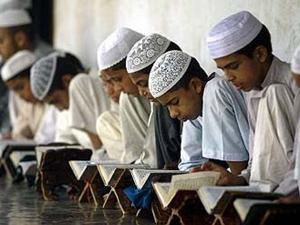The pro-right Maharashtra government of Indian state wants madrasas (place of dars, i.e. teaching) to go beyond Islam and include science, maths and physics in its curriculum—or face being derecognized as “non-schools.”
It’s essential that madrasas in India, and worldwide, are understood in their historical and current context. Most of the experts we read or watch on television would probably accept they have never been to a madrasa in their lives.
First, all madrasas differ in their views on Islam. They could be Jamat-e-Islami, Barelwi, Deobandi or Ahle Hadis. Each one of them has its own interpretation of Islam. Such madrasas naturally want their viewpoints to prevail and their sets of students are initiated in Islam of their kind. Most of them have no time to think or speak about Hinduism or Christianity.
These are, what could be termed, independent madrasas. There are also state-funded madrasas which more or less are regular schools. They do go beyond Islam and teach other subjects.
A closely-held belief worldwide is that madrasas are factories for producing terrorists. Most researched studies have debunked this theory. There is no evidence that madrasas teach students to indulge in acts of terrorism. Indeed, the profiles of most terrorists suggest they have been college or university- educated and are tech-savy. Yes, some terrorists did go to madrasas in their initial years but by that logic even “London School of Economics (LSE) is a jihad factory because Omar Saeed, the British jihadi convicted of killing Daniel Pearl, studied there,” writes Arshad Alam in Outlook magazine.
Saral Jhingran, in her 2012 book, “Madrasa Education in Modern India: A Study,” is unconvinced that only 4 percent Indian Muslim children go to madrasas, as mentioned by Sachar Committee. “The feedback…from (madrasas) pass outs now studying in JNU, or those who have roots in villages, puts the number of madrasa-going children much higher…around 15-30 percent..”
Jhingran spells out why Indian Muslims prefer madrasa education for their children: (a) paucing of modern schools in Muslim-majority area; (b) lack of separate girls’ schools and even female teachers in common schools; (c) cost of modern education; (d) genuine grievance of orthodox Muslims that there is a Hindu bias in school text books.
Most Muslims in India are poor. Most of them are converts from low Hindu caste. Madrasas hold an appeal for them as it provides free education and are also conveniently located. The beginners go through maktab madrasas; then there is middle level wheren Qur’an, hadith etc are taught. Finally, the highest-levels are graduate and post-graduate studies where studies of Arabic and Greek sciences go hand-in-hand.
Madrasas came to India from the earliest Prophet’s lifetime through Kerala. Later, it made foray from Sindh in North India. People in hundreds converted to Islam. But these were largely informal madrasas. The formal ones are traced back to 11th century, in Khurasan and Baghdad.
In Moghul Era, Fatehullah Shirazi during Akbar’s reign introduced rational sciences (ma’qulat) in madrasas curriculum. Rational sciences included astronomy, geography, physics and philosophy though it must be said they were largely derived from Greek sources and have long required a revision. During Aurangzeb’s reign in the 17th century, “…a team of scholars (were asked) to prepare a digest of Islamic law, later on called Fataw-i-Alamgiri. Then he granted Mullah Nizamuddin a mansion in Lucknow, known as Firangi Mahal where he established a madrasa. It was a predecessor of later madrasas and became a renowned centre of Islamic learning,” writes Jhingran.
Madrasas have played an important role in modern Indian history. In Kolkata, there was Madrasa Aliyah which later was granted a university-status by the West Bengal government. Incidentally, noted social reformer Raja Rammohan Roya studied in Madrasa Aliya.
Madrasas in recent years are seen to promote separate identity among Muslim children. But in a diverse and polarized society such as India, such identity is unavoidable in any religious or ethnic group, be it a major or minority group. Supporters of madrasas claim that it may not produce NCERT, CBSE or UGC graduates but the pass-outs indeed are god-fearing, law-abiding citizens.
The present move by the Mahrashtra government does appear to be politically motivated. Discerners link it to a pronouncement by BJP MP Sakshi Maharaj last year: “Education of terrorism is being given in madrasas…Muslim youth in madrasas are being motivated for “love jihad” with offers of cash rewards.” The Budhadeb Bhattacharya of the Communist Party of India (Marxist) had made a similar statement when he was the chief minister of West Bengal.
The present move could even end up strengthening the hands of conservative, orthodox Muslim leadership and its extreme elements. It could lead to further polarization of society—but then that could have been the real motive in the first place.


